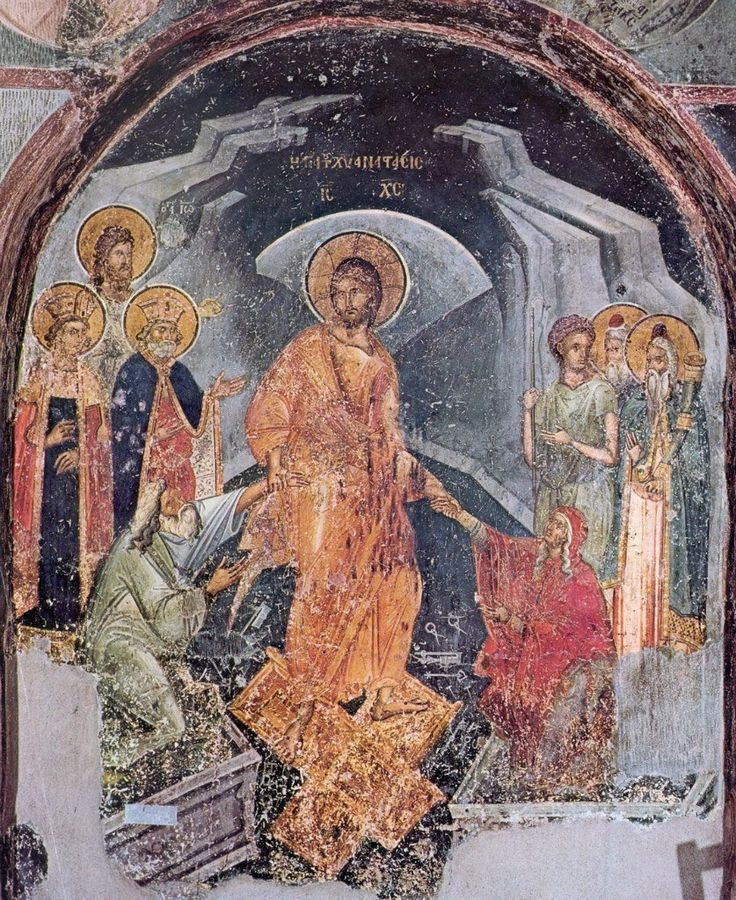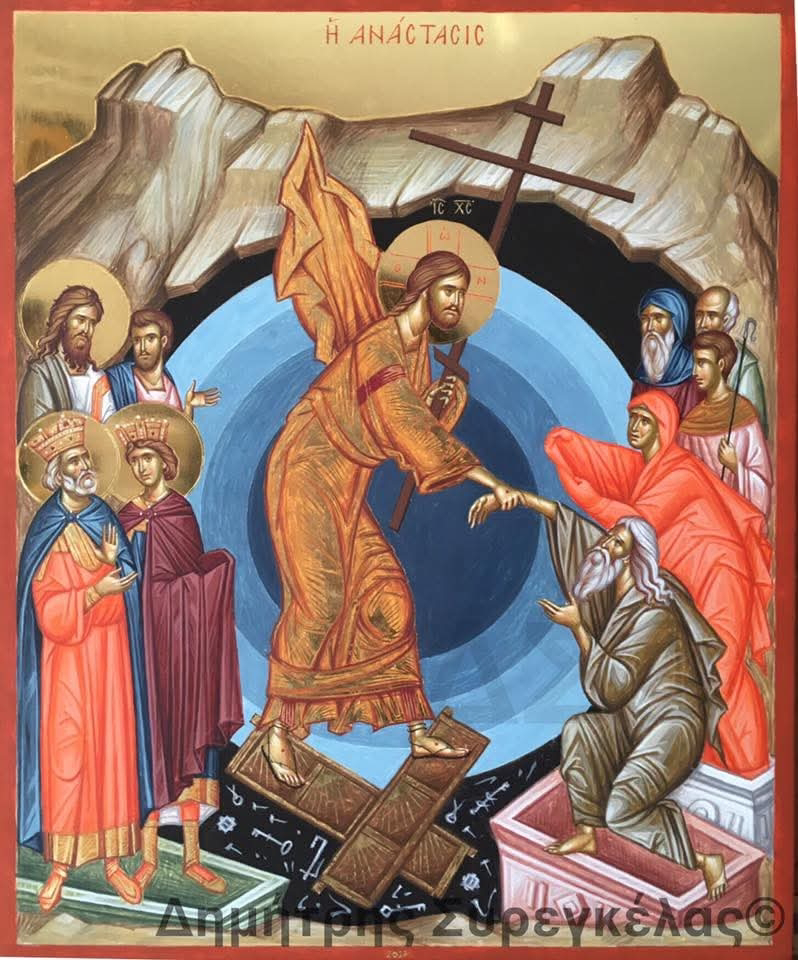Η ΕΙΣ ΑΔΟΥ ΚΑΘΟΔΟΣ
Το θέμα αὐτῆς τῆς εἰκόνας ἐμφανίστηκε στο Βυζάντιο πιθανῶς τὸν 12ο αἰώνα καί βασίστηκε κατά πολύ στή μαρτυρία πού περιέχει τό ἀπόκρυφο Εὐαγγέλιο τοῦ Νικοδήμου.
Ὁ Κύριος ἀναπαριστάνεται σε κίνηση Καθόδου πρός τόν Ἅδη' περιτριγυρίζεται ἀπό λάμψεις πού διασχίζουν ἀκτῖνες, ἀπό οὐράνιους κύκλους πού ἐπισημαίνουν τήν ὑπεροχή καί τή θεϊκή του δόξα. Γύρω ἀπό τόν Σωτήρα μαζεμένοι οἱ ἅγιοι Προπάτορες, οἱ μάρτυρες τῆς Παλαιᾶς Διαθήκης, οἱ όμολογητές καί οἱ προφῆτες. Ανάμεσα στούς προφήτες ὁ Ἰωάννης ὁ Βαπτιστής ὁ ὁποῖος στάλθηκε μέ τόν θάνατό του ἀπό τόν Ἡρώδη στόν Ἅδη ν' ἀναγγείλει τή μέλλουσα Ανάσταση τοῦ Χριστοῦ καί τήν κάθοδό του στόν Ἅδη. Ο Σωτήρας πατᾶ τίς σπασμένες πύλες τοῦ Ἅδη. Κρατᾶ τόν Σταυρό, λάβαρο τῆς νίκης του ἐναντίον τοῦ θανάτου. Απλώνει το χέρι του στούς πρωτοπλάστους Αδάμ καί Εὔα ἐγείροντάς τους δυναμικά από τὸ μνῆμα. Τό μνῆμα δείχνει τήν κατάρα τοῦ θανάτου που ὑπέστησαν οἱ παρακούοντες τή θεϊκή ἐντολή. Σ' αὐτό τό σημεῖο ή εἰκόνα ὑπογραμμίζει ἰδιαίτερα τήν ἔννοια τῆς ἀνάστασης, την ἀνέγερση ἀπό τήν πρώτη πτώση, τή συντριβή τοῦ τάφου -σημα θανάτου. Ο Σωτήρας παρουσιάζεται σ' αὐτήν την εἰκόνα σάν ἥλιος πού κατεβαίνει στον "Άδη. Κάθε του κίνηση είναι γεμάτη ἀπό ὁρμή. Οἱ ἄκρες τοῦ ἐνδύματός του εἶναι γυρισμένες καί σηκωμένες ἀπό τήν ὀρμητική δύναμη τῆς κατάβασής του στόν "Άδη. Τα πόδια του πατοῦν τίς σπασμένες πύλες τοῦ κάτω κόσμου, ριγμένες σε σχῆμα σταυροῦ πάνω στο χάος -Βασίλειο τῆς Κόλασης καί τοῦ Θανάτου, σάν ἕνα ἄλλου εἶδους τόξο στο χέρι ἑνός πολεμιστῆ. Ὁ Κύριος μέ τό δεξί του χέρι κρατά γερά το χέρι τοῦ ᾿Αδάμ καί κουρασμένο από τον θανάτιο ὕπνο του τόν τραβά ἔξω ἀπό τόν τάφο. Το αριστερό χέρι τοῦ Ἀδάμ, ἀδύναμο, μοιάζει νά ξεκουράζεται μέσα στο χέρι τοῦ Χριστοῦ. Ἡ κίνηση τοῦ δεξιοῦ χεριοῦ τοῦ Ἀδάμ, κίνηση αὐτόνομη, ἐκφράζει τήν προσωπική θέλησή του καί τείνει πρός τόν Χριστό σάν προσευχή. Μ' αὐτήν τήν ἀντιθετική κίνηση τῶν χεριῶν τοῦ ᾿Αδάμ ἀνοίγεται μυστικά ἡ ἀναζωογόνηση τοῦ ἀνθρώπου πού πηγάζει ἀπό τήν ἀνάσταση, ἡ πλήρης κατάργηση τοῦ θανάτου, ἡ ἐσωτερική δύναμη τῆς ψυχῆς πού τείνει πρός τόν Θεό. Στό πρόσωπο τοῦ ἀναστημένου Αδάμ σαλεύουν μέ τόν ἴδιο τρόπο ή φθορά τοῦ θανάτου καί ή χαρά τῆς νέας συνάντησής του μέ τόν Δημιουργό του. Στήν ἀπέναντι ὄχθη τοῦ Ἅδη ή Εὔα γονατισμένη, μέ καλυμμένα τά χέρια της ἀπό τίς ἄκρες τοῦ ἐνδύματός της τ' ἁπλώνει πρός τόν Κύριο. Στά δεξιά τοῦ Χριστοῦ, ὁ χορός τῶν Προφητῶν μ' ἐπικεφαλῆς τόν Πρόδρομο, πού εἶχε ἀναγγείλει στόν κάτω κόσμο, μετά τό μαρτύριό του, τήν Ανάσταση τοῦ Κυρίου. Στό άριστερό χέρι τοῦ Λυτρωτῆ, ἀπό τήν πλευρά τῆς Εὔας, βλέπουμε τόν χορό τῶν Προπατόρων. Τά βουνά στο ἄνω μέρος τῆς εἰκόνας, πλησιάζοντας τίς κορυφές τους, σημειώνουν κι αὐτά τό «πέρασμα» τῆς κατάβασης στόν Ἅδη. Ακριβῶς πάνω ἀπό τά βουνά δυό ἄγγελοι μέ τά σύμβολα τοῦ Πάθους: τόν Σταυρό, τόν κάλαμο μέ τόν σπόγγο τοῦ ὄξους καί τῆς χολῆς καί τό μαστίγιο.
Εἶναι ὁ θρίαμβος τῆς ἀπελευθέρωσης ἀπό τόν βαρύ ὕπνο τοῦ Θανάτου. Νά γιατί ὁ Χριστός τῆς Ἀνάστασης εἰκονίζεται μέ αὐτόν τον δυναμικό τρόπο, τῆς διάρρηξης τῶν δεσμῶν τοῦ Ἅδη, τῆς ἔγερσης ἀπό τόν τάφο, τῆς νίκης πάνω στη δύναμη τῆς γῆς πού εἶναι εἰκόνα τῆς ἁμαρτωλότητάς μας, τῆς φθαρτότητάς μας, εἰκόνα τῆς ὑποταγῆς μας στόν θάνατο. Στήν εἰκόνα τῆς Ἀνάστασης ὁ Χριστός Σωτήρας γίνεται καθοδηγητής τοῦ ἀνθρώπινου γένους, πού καλεῖ ὅλο τον κόσμο νά τόν ἀκολουθήσει γίνεται ὁ ἀγγελιαφόρος τῆς γενικῆς ἀνάστασης.
Το θέμα τῆς «εἰς Ἅδου Καθόδου» ἐμφανίστηκε για πρώτη φορά στο Βυζάντιο καί διαδόθηκε ἀργότερα στη Δύση. Μέσα στη ρωμαιοκαθολική Εκκλησία, ὅμως, ἡ εἰκόνα ἔχασε τό νόημά της, ἔχασε τόν εἰδικό, πνευματικό χαρακτήρα της ἄρχισε ή Ανάσταση να παρουσιάζεται σαν ἕνα στιγμιαίο γεγονός, μυστηριώδες καί ἀπρόσιτο, φορτωμένο μ' ἕνα πλῆθος λεπτομερειῶν, ὅπως οἱ πεσμένοι στρατιώτες μπροστά στον τάφο, βλέ-
ποντας τήν ἔγερση τοῦ Χριστοῦ. Στή συνέχεια ἡ εἰκόνα αὐτή γινόταν ὅλο καί πιό πιστή στό στιγμιαῖο γεγονός τῆς ἱστορικῆς ἀφήγησης, προσπαθώντας να δείξει ἕνα πανόραμα αίσθητῶν πραγμάτων: ὅσων «τό μάτι δέν εἶδε καί τό αὐτί δέν ἄκουσε». Κατέληξε μιά παραμορφωμένη μαρτυρία τῆς Ἀνάστασης τοῦ Χριστοῦ, κατά τόν πατριάρχη Σέργιο. Ο Λεωνίδας Οὐσπένσκυ ἀναφέρει τήν ἐξήγηση τοῦ Ἀβελάρδου, λέγοντας πώς ἡ ἀναπαράσταση τῶν στρατιωτῶν εἶναι ἀπαραίτητη σάν μαρτυρία πού πιστοποιεῖ τήν αὐθεντικότητα κάθε γεγονότος ἀλλά οἱ στρατιῶτες ὑπῆρξαν μάρτυρες, ὄχι θεατές τῆς ἴδιας τῆς στιγμῆς τῆς Ἀνάστασης.
Μ' αὐτή τή μορφή, τήν ἀπομακρυσμένη καί ἀλλοιωμένη, ή εἰκόνα τῆς ᾿Ανάστασης, ἔτσι ὅπως διαμορφώθηκε ἀπό τή ρωμαιοκαθολική Ἐκκλησία, ἐπιστρέφει στήν ὀρθοδοξία, μή ἔχοντας διατηρήσει μέσα της τίποτε ἄλλο παρά τήν ἰδέα τῆς ᾿Ανάστασης, «διδάσκοντας» κατά κάποιο τρόπο τό μυστήριο τοῦ Θεοῦ. Κι εἶναι ἡ περίπτωση πολλῶν εἰκόνων. Μέσα σ' ἕνα περιβάλλον ξεκομμένο ἀπό τήν ἑνότητα τῆς Ἐκκλησίας οἱ εἰκόνες ἀρχίζουν νά νεκρώνονται, νά παραμορφώνονται, νά χάνουν τή ζωτική δύναμή τους γιά νά ξαναβροῦν τὸ πρῶτο τους φῶς καί νά λάμψουν, πρέπει νά ἐπιστρέψουν στήν ἐκκλησιαστική πηγή πού τίς γέννησε. Νά ὑποφέρουν, να πεθάνουν μέτόν Χριστό καί νά ἀναστηθοῦν μαζί Του.
Πηγή:
ΣΗΜΕΙΩΣΕΙΣ ΕΝΟΣ ΕΙΚΟΝΟΓΡΑΦΟΥ .
Π.Γρηγορίου Κρούγκ. Εκδοσεις Παναγόπουλου
Μεταφραση Σπυριδωνος Μαρίνη
–————————————
THE DESCENT INTO HADES
The theme of this image first appeared in Byzantium, probably in the 12th century, and is largely based on the testimony found in the apocryphal Gospel of Nicodemus.
The Lord is depicted in motion, descending into Hades, surrounded by radiant beams and celestial circles that signify His supremacy and divine glory. Around the Savior are gathered the holy Forefathers, the martyrs of the Old Testament, the confessors, and the prophets. Among the prophets stands John the Baptist, who was sent to Hades by Herod through his martyrdom to announce the forthcoming Resurrection of Christ and His descent into Hades. The Savior stands atop the broken gates of Hades. He holds the Cross, the banner of His victory over death. He stretches out His hand to the first-created humans, Adam and Eve, lifting them powerfully from the grave. The tomb represents the curse of death endured by those who disobeyed the divine command.
At this point, the icon emphasizes the meaning of the Resurrection—the rising from the first fall, the shattering of the tomb as a symbol of death. The Savior appears in this image as a sun descending into Hades. Every movement He makes is filled with dynamic force. The edges of His garment are lifted and turned by the forceful energy of His descent into Hades. His feet step upon the broken gates of the underworld, cast into the shape of a cross upon the chaos—the realm of Hell and Death—like another kind of bow in a warrior's hand.
With His right hand, the Lord firmly grasps the hand of Adam, weary from the slumber of death, pulling him out of the grave. Adam's left hand, weak, appears to rest within Christ's hand. The movement of Adam’s right hand, autonomous and expressive of his personal will, stretches toward Christ like a prayer. Through this contrasting movement of Adam's hands, the secret of human renewal through the Resurrection is revealed—the total abolition of death, the inner strength of the soul striving toward God. In the face of the resurrected Adam, the decay of death and the joy of his renewed encounter with his Creator move together.
On the opposite side of Hades, Eve is kneeling, her hands wrapped in her garment, extending them toward the Lord. At Christ’s right, the choir of the Prophets is led by the Forerunner, who announced the Lord’s Resurrection to the underworld after his martyrdom. On the Redeemer’s left, on Eve’s side, we see the choir of the Forefathers. The mountains in the upper part of the icon, converging toward their peaks, also indicate the “passage” of the descent into Hades. Just above the mountains, two angels bear the symbols of the Passion: the Cross, the reed with the sponge soaked in vinegar and gall, and the whip.
It is the triumph of liberation from the heavy sleep of Death. That is why the Christ of the Resurrection is depicted in this powerful way—shattering the bonds of Hades, rising from the tomb, victorious over the power of the earth, which is a symbol of our sinfulness, our mortality, our submission to death. In the icon of the Resurrection, Christ the Savior becomes the guide of the human race, calling all to follow Him—He becomes the herald of the universal resurrection.
The theme of the “Descent into Hades” first appeared in Byzantium and later spread to the West. In the Roman Catholic Church, however, the image lost its meaning and special spiritual character. The Resurrection began to be depicted as a momentary, mysterious, and inaccessible event, burdened with a multitude of details, such as fallen soldiers before the tomb witnessing Christ's rising.
Over time, this image became more faithful to the momentary nature of the historical narrative, attempting to portray a panorama of sensory events—“what the eye has not seen and the ear has not heard.” It ended up as a distorted testimony of Christ's Resurrection, according to Patriarch Sergius. Leonid Ouspensky refers to Abelard’s explanation, stating that the depiction of the soldiers is necessary as a testimony verifying the authenticity of each event—but the soldiers were witnesses, not spectators, of the very moment of the Resurrection.
In this altered and remote form, the image of the Resurrection, as shaped by the Roman Catholic Church, returns to Orthodoxy, having preserved nothing but the idea of the Resurrection—“teaching,” in a way, the mystery of God. This is the case with many icons. In an environment disconnected from the unity of the Church, icons begin to lose life, to be distorted, to lose their vital power. In order to regain their original light and to shine, they must return to the ecclesiastical source that gave them birth. They must suffer, die with Christ, and rise again with Him.
Source:
NOTES OF AN IKONOGRAPHER.
Fr. Gregory Krug. Panagopoulos Publications.
Translation by Spyridon Marinis














